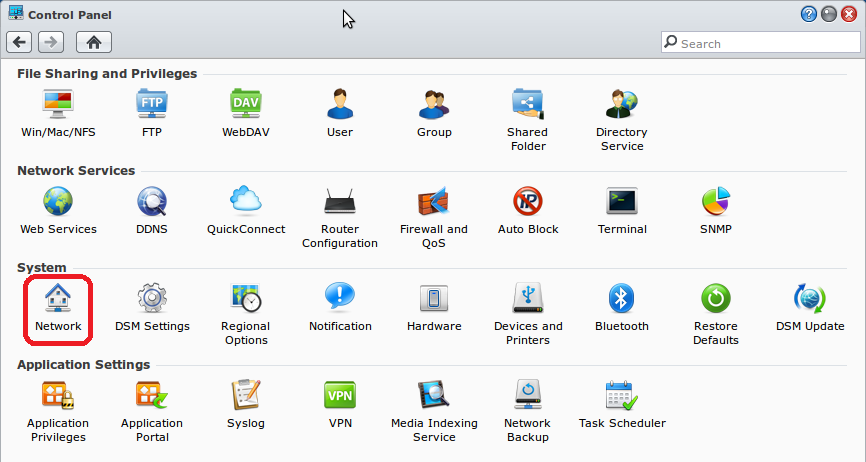
- #HOW TO CONFIGURE SYNOLOGY NAS INSTALL#
- #HOW TO CONFIGURE SYNOLOGY NAS FOR ANDROID#
- #HOW TO CONFIGURE SYNOLOGY NAS SOFTWARE#
- #HOW TO CONFIGURE SYNOLOGY NAS DOWNLOAD#
- #HOW TO CONFIGURE SYNOLOGY NAS FREE#
#HOW TO CONFIGURE SYNOLOGY NAS FREE#
DS photo lets you select if you just want to upload photos (instead of both photos and videos) and delete the photos from your phone's internal storage once they've been uploaded to the NAS to free up storage.īut wait, there's more. I used DS Photo for the longest time but switched to Moments recently.
#HOW TO CONFIGURE SYNOLOGY NAS INSTALL#
You'll need to install the Photos Station package on the NAS first and set up DS Photo on your phone. You could try using DS Photo, which also lets you upload photos and videos automatically from your phones to the NAS. The caveat with Moments is that it takes an inordinate amount of time to transfer photos in bulk. I use Moments to back up full-res photos from all my phones and turn to Google Photos for high-quality uploads. It also leverages face recognition to sort images automatically and creates albums. If you're looking at a NAS as a Google Photos alternative, Moments is the obvious choice. Once you log in, you can set it up, so the service automatically uploads photos and videos from your phone to your NAS.
#HOW TO CONFIGURE SYNOLOGY NAS FOR ANDROID#
You should install the Moments package on your NAS first and set up the app on your phone - it's available for Android and iOS.

If you just need to back up all the photos and videos on your phone, you'll want to use Synology Moments. If you want to back up your phone, there are a few options available. Synology makes it as easy as possible to back up your Windows and macOS computers. Similarly, with macOS, you can use Time Machine with your NAS to back up data automatically. You can then set up two-way sync to save changes between your machine and the NAS, or just select folders that you want to be uploaded to the NAS and set an interval for backing up data.Īlternatively, if you can use Windows 10's built-in File History feature, you can point that backup to your enclosure and have the data stored on your NAS.
#HOW TO CONFIGURE SYNOLOGY NAS DOWNLOAD#
Just install Synology Drive Server on the NAS, and download the client service on your Windows and macOS machines. This tutorial was based on the generic NAS instructions written by over on the SiliconDust forums, adapted for Synology.Synology makes it as easy as possible to back up data from all devices.
#HOW TO CONFIGURE SYNOLOGY NAS SOFTWARE#
He has also created an auto-update script to automate the DVR software updates on his Synology, i haven’t tried it yet myself but you can check it out here if you wish. You can now schedule recordings on your NAS and access recordings via the VIEW app.Īll credit for the auto-start script goes to on the SiliconDust forums. You should now see the DVR status as running. At the command prompt paste the following commands (right click to paste, press return after each command): Press the ‘i’ key, and paste the following text: At the command prompt paste the following commands (right click to paste, press return after each command): When prompted enter your SSH credentials as before (Step 6.) Open Putty and type the IP address of your NAS, select the ‘SSH’ radio button. Now we need to configure the NAS to start the record engine automatically when the system boots. The NAS should now download and install the record engine and report success. When prompted for SSH credentials use ‘root’ as the user, with your admin password. Double click the one you wish to use as the DVR record engine. The setup will search for all available NAS devices on your network. Step 6. Run HDHomeRun Setup, go the the DVR tab, and click the NAS Install button. Create a new shared folder to store recordings, navigate to:Ĭontrol Panel > Shared Folder > Click ‘Create’, name the folder ‘HDHomeRun’, provide a custom description if you wish, then click ‘Ok’

Login to the Synology DSM web manager and navigate to:Ĭontrol Panel > Terminal & SNMP > Check the ‘Enable SSH service’ option, click ‘Apply’ NT: You must be on 20150701atest1 or later. Download and install the latest HDHomeRun software NT. Account activation is only available to Kickstarter supporters and direct customers who have purchased the DVR software from SiliconDust. You need to follow the instructions in the e-mail to activate your account. Purchase a HDHomeRun DVR subscription and activate it. For terrestrial broadcast you need either a Connect/2 or Extend, and for satellite/cable you need the HDHomeRun Prime

Purchase a compatible HDHomeRun digital tuner. The following tutorial describes in simple steps the process to install the HDHomeRun DVR record engine on a Synology NAS.


 0 kommentar(er)
0 kommentar(er)
